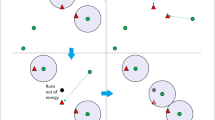Abstract
The reliability of wireless sensor network is affected by the credibility of nodes. With the addition of random nodes and increase of coverage, the reliability decreases. In order to improve the reliability of wireless sensor network, a reliability analysis method of intelligent computing-oriented wireless sensor network is proposed. In this method, a node optimization deployment model of wireless sensor network is established; The adaptive rotation scheduling method is adopted for optimal design of networking routing of wireless sensor network; the sensor quantization fusion tracking method is adopted for quantification of the credibility of sensor gird points; then the reliability of wireless sensor network is measured based on the analysis results with quantization fusion to improve the reliability of wireless sensor network, so as to achieve optimal network design. The simulation results show that with the proposed method in construction of wireless sensor network, the reliability of network is good. With the increase of bit error probability and packet length, the energy cost of network is gradually smaller and smaller, and the minimum energy cost can approach to 0.01 kJ, which indicates that the anti-attack ability of the proposed method is strong. When the number of data forwarding is 700, the success reception rate can reach 100%. Therefore, the proposed method is of good application value in wireless sensor network networking.





Similar content being viewed by others
References
Lang, L.Y., Wang, Y., Bai, W.Q., et al.: Accurate reconstruction of compressed sensing based on CoSaMP algorithm. Appl. Res. Comput 32(8), 2554–2557 (2015)
Donoho, D.L., Tsaig, Y., Drori, I., et al.: Sparse solution of underdetermined systems of linear equations by stagewise orthogonal matching pursuit. IEEE Trans. Inf. Theory 58(2), 1094–1121 (2012)
Wang, A., Wang, Y., Jiang, L.: Improved sparse channel estimation for multi-user massive MIMO systems with compressive sensing. In: Proceedings of the 2015 International Conference on Wireless Communications & Signal Processing. Piscataway, NJ:IEEE, pp. 1–5 (2015)
Li, Z., Yu, J., Bian, C., Wang, Y., Lu, L.: Dynamic data stream load balancing strategy based on load awareness. J. Comput. Appl. 37(10), 2760–2766 (2017)
Deif, D., Gadallah, Y.: A comprehensive wireless sensor network reliability metric for critical Internet of Things applications. Eurasip J. Wirel. Commun. Netw. 2017(1), 145–146 (2017)
Leonardo, E.J., Yacoub, M.D.: Exact formulations for the throughput of IEEE 802.11 DCF in Hoyt, Rice, and Nakagami-m fading channels. IEEE Trans. Wirel. Commun. 12(5), 2261–2271 (2013)
Marimon, M.C., Tangonan, G., Libatique, N.J., et al.: Development and evaluation of wave sensor nodes for ocean wave monitoring. IEEE Syst. J. 9(1), 292–302 (2015)
Jeon, W.S., Han, J.A., Dong, G.J.: A novel MAC scheme for multichannel cognitive radio Ad Hoc networks. IEEE Trans. Mob. Comput. 11(6), 922–934 (2012)
Wang, J., Lu, J., Zeng, X.: Data aggregation scheme for wireless sensor network to timely determine compromised nodes. J. Comput. Appl. 36(9), 2432–2437 (2016)
Wu, X.: Enhanced stable group model-based trust evaluation scheme for mobile P2P networks. Chin. J. Comput. 37(10), 2118–2127 (2014)
Palomares, I., Martinez, L., Herrera, F.: A consensus model to detect and manage non-cooperative behaviors in large scale group decision making. IEEE Trans. Fuzzy Syst. 22(3), 516–530 (2014)
Zhao, M., Fu, Z., Yuan, Y., et al.: System Reliability analysis for wind turbine condition monitoring system based on wireless sensor networks. Proc. CSU-EPSA 28(3), 35–41 (2016)
Prihtiadi, H., Djamal, M.: The reliability of wireless sensor network on pipeline monitoring system. J. Math. Fundam. Sci. 49(1), 51–56 (2017)
Dong, T.: Assessment of data reliability of wireless sensor network for bioinformatics. Int. J. Bioautomotion 21(3), 241–250 (2017)
Zonouz, A.E., Xing, L., Vokkarane, V.M., et al.: Application communication reliability of wireless sensor networks. Wirel. Sens. Syst. IET 5(2), 58–67 (2015)
Jang, W.S., Du, Y.K., Skibniewski, M.J.: Reliability performance of wireless sensor network for civil infrastructure –part I: experimental analysis. J. Civil Eng. Manag. 22(1), 105–117 (2016)
Liu, Y., Zhao, Y., Zhao, Y., et al.: The reliability analysis of wireless sensor networks based on the energy restrictions. Int. J. Wirel. Mob. Comput. 10(4), 399–406 (2016)
Yu, T.: Simulation of Wireless sensor networks based on directed diffusion algorithm. Int. J. Online Eng. 13(10), 73 (2017)
Engmann, F., Abdulai, J.D., Azasoo, J.Q.: Improving on the reliability of wireless sensor networks.In: International Conference on Computational Science and ITS Applications. IEEE, vol. 24 no. 23, pp. 87–91 (2015)
Yang, D., Xu, Y., Wang, H., et al.: Assignment of segmented slots enabling reliable real-time transmission in industrial wireless sensor networks. IEEE Trans. Indust. Electron. 62(6), 3966–3977 (2015)
He, D., Mujica, G., Portilla, J., et al.: Modelling and planning reliable wireless sensor networks based on multi-objective optimization genetic algorithm with changeable length. J. Heuristics 21(2), 257–300 (2015)
Acknowledgments
This work is supported by National Natural Science Foundation of China under grant no. 51409090, and 41471427;The Fundamental Research Funds for the Central Universities(no.2010B08614). Special Basic Research Key Fund for Central Public Scientific Research Institutes (no.Y515018, Y516004, Y517017, Y517018); Technology Foundation for Selected Overseas Chinese Scholar, Ministry of Personnel of China (no.Rq515001).
Author information
Authors and Affiliations
Corresponding author
Rights and permissions
About this article
Cite this article
Xu, J., Liu, Y. & Meng, Y. Analysis and simulation of reliability of wireless sensor network based on node optimization deployment model. Cluster Comput 22 (Suppl 3), 7585–7591 (2019). https://doi.org/10.1007/s10586-018-2322-9
Received:
Revised:
Accepted:
Published:
Issue Date:
DOI: https://doi.org/10.1007/s10586-018-2322-9




